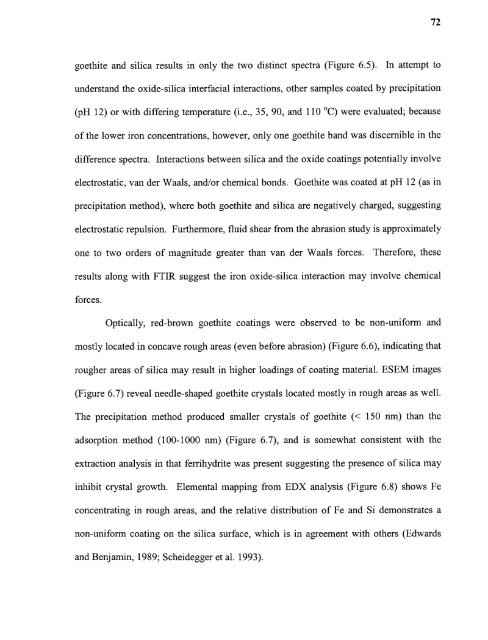Heavy metal adsorption on iron oxide and iron oxide-coated silica ...
Heavy metal adsorption on iron oxide and iron oxide-coated silica ...
Heavy metal adsorption on iron oxide and iron oxide-coated silica ...
Create successful ePaper yourself
Turn your PDF publications into a flip-book with our unique Google optimized e-Paper software.
72goethite <strong>and</strong> <strong>silica</strong> results in <strong>on</strong>ly the two distinct spectra (Figure 6.5). In attempt tounderst<strong>and</strong> the <strong>oxide</strong>-<strong>silica</strong> interfacial interacti<strong>on</strong>s, other samples <strong>coated</strong> by precipitati<strong>on</strong>(pH 12) or with differing temperature (i.e., 35, 90, <strong>and</strong> 110 °C) were evaluated; becauseof the lower ir<strong>on</strong> c<strong>on</strong>centrati<strong>on</strong>s, however, <strong>on</strong>ly <strong>on</strong>e goethite b<strong>and</strong> was discernible in thedifference spectra. Interacti<strong>on</strong>s between <strong>silica</strong> <strong>and</strong> the <strong>oxide</strong> coatings potentially involveelectrostatic, van der Waals, <strong>and</strong>/or chemical b<strong>on</strong>ds. Goethite was <strong>coated</strong> at pH 12 (as inprecipitati<strong>on</strong> method), where both goethite <strong>and</strong> <strong>silica</strong> are negatively charged, suggestingelectrostatic repulsi<strong>on</strong>. Furthermore, fluid shear from the abrasi<strong>on</strong> study is approximately<strong>on</strong>e to two orders of magnitude greater than van der Waals forces. Therefore, theseresults al<strong>on</strong>g with FTIR suggest the ir<strong>on</strong> <strong>oxide</strong>-<strong>silica</strong> interacti<strong>on</strong> may involve chemicalforces.Optically, red-brown goethite coatings were observed to be n<strong>on</strong>-uniform <strong>and</strong>mostly located in c<strong>on</strong>cave rough areas (even before abrasi<strong>on</strong>) (Figure 6.6), indicating thatrougher areas of <strong>silica</strong> may result in higher loadings of coating material. ESEM images(Figure 6.7) reveal needle-shaped goethite crystals located mostly in rough areas as well.The precipitati<strong>on</strong> method produced smaller crystals of goethite (< 150 nm) than the<str<strong>on</strong>g>adsorpti<strong>on</strong></str<strong>on</strong>g> method (100-1000 nm) (Figure 6.7), <strong>and</strong> is somewhat c<strong>on</strong>sistent with theextracti<strong>on</strong> analysis in that ferrihydrite was present suggesting the presence of <strong>silica</strong> mayinhibit crystal growth. Elemental mapping from EDX analysis (Figure 6.8) shows Fec<strong>on</strong>centrating in rough areas, <strong>and</strong> the relative distributi<strong>on</strong> of Fe <strong>and</strong> Si dem<strong>on</strong>strates an<strong>on</strong>-uniform coating <strong>on</strong> the <strong>silica</strong> surface, which is in agreement with others (Edwards<strong>and</strong> Benjamin, 1989; Scheidegger et al. 1993).
















